
- Permbajtja
- prev
- next
- prev
- next
HIGHLIGHT: MARIO BELLINI
Early life and career
Mario Bellini (born February 1, 1935, Milan) is an Italian architect and designer. He graduated from the Milan Polytechnic - Faculty of Architecture in 1959 and began working as an architect himself in the early 1960s. He is the winner among others of 8 Compasso d’Oro and prestigious architecture awards including the Medaglia d’Oro conferred on him by the President of the Italian Republic.
Like many other Italian architects, his activities range from architecture and urban planning to product and furniture design.
Design
His career as a product and furniture designer began in 1963, and from 1963 to 1991 he was chief design consultant for Olivetti. For many years he designed furnishing products and systems for B&B Italia and Cassina, TV sets for Brionvega, and hi-fi systems, headphones and electric organs for Yamaha.
For five years he worked as an automobile design consultant with Renault.
In 1972 he was commissioned to design and build the prototype of the Kar-a-Sutra mobile environment for the exhibition “Italy: the New Domestic Landscape” at the Museum of Modern Art in New York.
He has also designed for Fiat and Lancia (notably the interior of the 1980 Lancia Trevi), lamps for Artemide, Erco and Flos, and office furniture for Vitra.
Other firms for whom he has designed and/or continues to design products include (in Italy) Acerbis, Bras, Driade, Candy, Castilia, Flou, Kartell, Marcatrè, Meritalia, Natuzzi and Poltrona Frau; (in Belgium) Ideal Standard; (in Germany) Lamy and Rosenthal; (in Japan) Fuji and Zojirushi; and (in the USA) Heller.
His early international success grew rapidly during the first two decades, especially in the design sector, and reached its peak in 1987 with a personal retrospective exhibition at the Museum of Modern Art of New York. At the time the museum already included 25 of his works in its Permanent Collection, including a remarkable set of Olivetti machines as well as the furniture for B&B and Cassina - such as the famous "Cab" chair - and the innovative office chairs designed for Vitra.
MBA's headquarters of 1,500 square metres in Milan were designed by Mario Bellini himself in the early 1990s, and today an average of 30 to 35 architects.
In 1999, MBA obtained ISO 9001 quality certification.
Architecture
Since the ‘80s, he has been increasingly successful in the field of architecture in Europe, Japan, the United States, Australia and the Arab Emirates.
Projects built
-Milan Convention Centre (MICO), Europe’s largest convention centre, 2008-2012
-Museum of Islamic Arts at Louvre Museum, Paris, 2005-2012
-Museum of the City of Bologna, Italy, 2004-2012
-Urban redevelopment “Verona Forum”, Verona, Italy, 2004–2011
-Radical refurbishment of the Deutsche Bank in Frankfurt, Germany, 2007–2011
-National Gallery of Victoria extension and redevelopment, Melbourne, Australia, 1996–2003
-Essen International Fair Extension, Germany, 1998–2001
-Natuzzi Americas Headquarters, High Point, North Carolina, USA, 1996–1998
-Arsoa Co./Cosmetics- Headquarters, Yamanashi, Japan, 1996–1998
-New fair district of the Milan Trade Fair, 1987–1997
-Risonare Vivre Club Complex, Kobuchizawa, Japan, 1989–1992
-Tokyo Design Center, Tokyo, Japan, 1988–1992
-Yokohama Business Park, Yokohama, Japan, 1987–1991
-Villa Erba Exhibition and Congress Centre, Cernobbio (Como), 1986–1990
-Thermoelectric power plant of Cassano d’Adda-Office building, 1985–1990
Among the best architectural creations
-New Museum of the city of Berlin, Germany, 2008
-Sheikh Zayed National Museum International Competition, Abu Dhabi, UAE, 2007
-European Patent Office, L’Aja, Holland, 2004
-Cittanova 2000, Modena, Italy, 2003
-Redevelopment of the City Centre of Tian Jin, China, 2003
-Banca CR Firenze-New H.Q., Italy, 2003
-New International Trade Fair of Milan – Rho/Pero, Milan, 2002
-Multifunctional Complex “MAB. Zeil Project”, Frankfurt, Germany, 2002
-Stolitza Towers, Moscow, 1996
-Dubai Creek Complex, Dubai, United Arab Emirates, 1994
-Goshikidai Marine Resort, Japan, 1993
Exhibitions
Avid art lover and collector, he has been responsible for the exhibition design of many art exhibitions, among which:
-"The Treasure of St. Marco in Venice", Grand Palais, Paris, and the major museums around the world, 1984–87
-"Italian Art in the 20th Century", Royal Academy of Arts, London, 1989
-"The Renaissance from Brunelleschi to Michelangelo. The Representation of Architecture", Palazzo Grassi, Venice, then in Paris and Berlin, 1994–95
-"The Triumphs of Baroque. Architecture in Europe 1600-1750", Stupinigi Hunting Palace, Turin, 1999
-"Christopher Dresser. A designer at the Court of Queen Victoria", Triennale, Milan, 2001
-“Annisettanta. Il decennio lungo del secolo breve”, Triennale, 2007–2008
-“Magnificenza e Progetto” Palazzo Reale, Milan, 2008–2009
Major personal exhibitions
-In 1987, the Museum of Modern Art in New York organised the exhibition “Mario Bellini: designer”, the first great retrospective on a living artist
-In 1996, the Royal Institute of British Architects (RIBA) held an exhibition of Bellini’s work as an architect
-In 2000, the Municipal Gallery of Contemporary Art of Trento, Italy held a personal show “Mario Bellini: a path between architecture, furniture and cars”
-In December 2003, the National Gallery of Victoria in Melbourne reopened with a major exhibition on his work.
-Dashboard for the Lancia Trevi

-Calculator logo for Olivetti
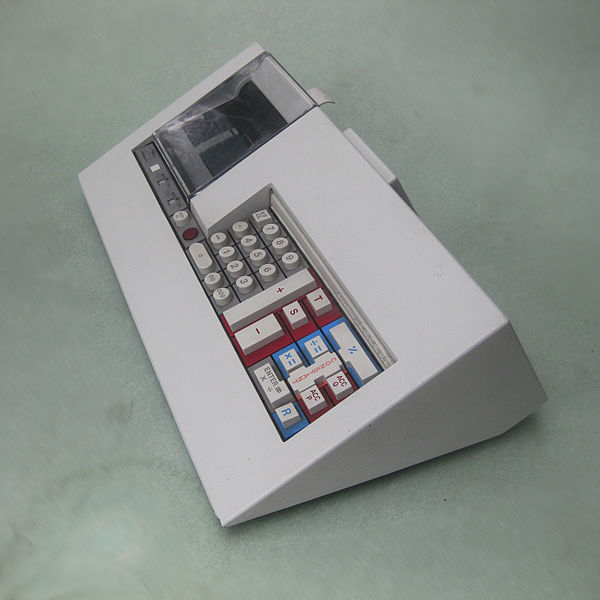
-Fuji DL 100 design

-Residential building in the Brera District
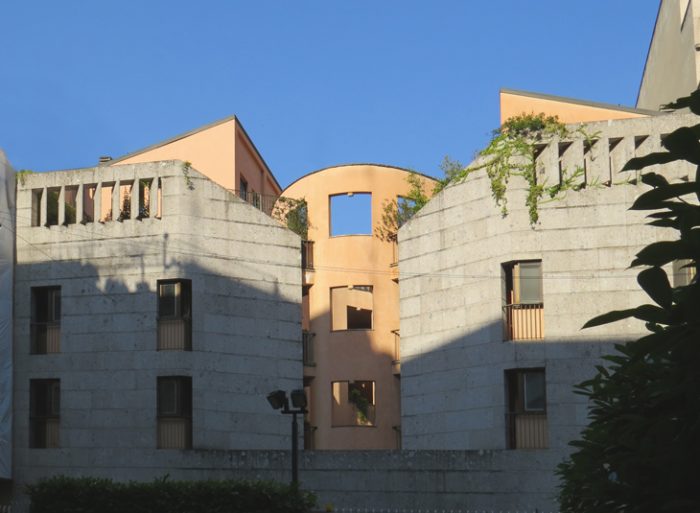
In one of the streets of the centre of Milan characterised by a nearly unbroken continuous façade from the 20th century, Bellini inserts a new residential building.
The structure is placed into continuity with the buildings around it: the street façade is maintained unaltered, following the rhythms and the arrangements typical to the street.
The exterior façade is done in Ceppo di Poltragno stone, like many other homes in Milan; the elliptical courtyard emerges onto the street with a figurative autonomy establishing a discreet relationship between the interior and exterior.
-Headquarters of Mario Bellini Architects
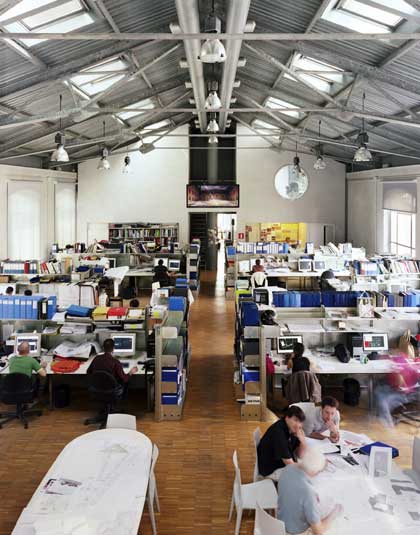
The project focuses on the transformation of the interior spaces only, leaving the exteriors of the courtyard unaltered, or rather only “touched” by small interventions, with the exception of the fourth side of the courtyard where a “triage” in iron gives the space a more rigorous geometry.
Elegance and lightness in the use of metal both in the interiors and the exteriors attribute an unusual nature to the place, divided between the vocation as a place of work and that of contemporary living by now far from the obviousness of the usual sort of residential spaces.
-London Linl' Bridge - Deutsche Bank

Bellini reintroduces in the centre of the City of London the theme of the “sphere” which he was using, almost contemporaneously, to reorganise the interiors of the Deutsche Bank buildings in Frankfurt.
The strength of the “symbol” is clearly that it is the functional link between two existing buildings of the same owner, conceived as a sort of “branding” of the Bank which, when repeated, could be immediately recognizable to the world. Paradoxically, if one compares the character of historical Italian cities, the proposal is very “contextual”, adeptly interpreting the multiform image which has been created over recent decades in the City of London.
-Mario Bellini a Murano
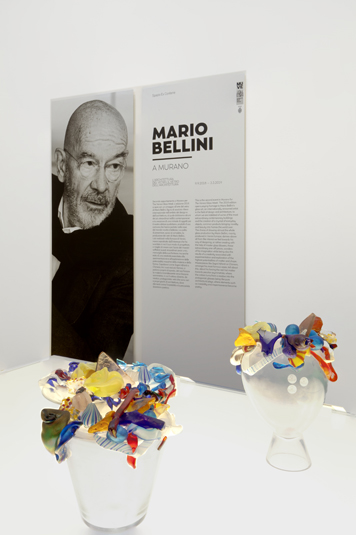
"For me, glass is transparency, lightness, magic. Not only in design where it is an explosion of light and color, but above all in architecture when it defines and protects, without depriving us, however, of the sky, horizons and urban theater". -MB
-Proposte 2018
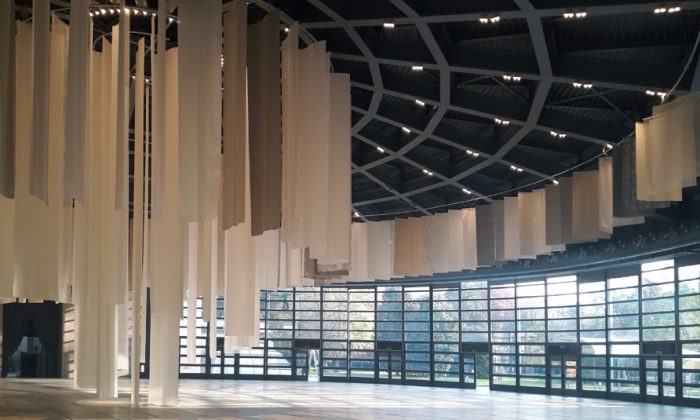
From the highest point, in the center of the pavilion roof, exactly at eleven meters, one hundred and thirty-three panels of various fabrics (all in a color close to white) hang to create an unexpected three-dimensional spiral of Archimedes. They hang at full height - starting from the center - to gradually shorten to just two meters, once they reach the seventh turn towards the outside. A textile installation, light and dynamic, which lives on the contribution of the exhibitors of Proposte for a sculpture that symbolically brings them all together, albeit respecting their different identities.